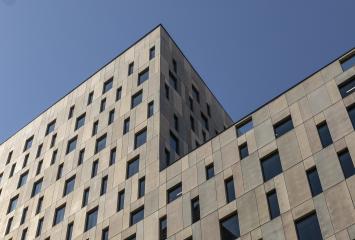Bioclimatic Design in Office Buildings
The current climatic reality of our planet, reflected not only in scientific research but also in the increasing occurrence of extreme weather events, has turned sustainable construction into an urgent necessity, rather than a mere added value. Buildings, regardless of their purpose, must take into account carbon footprint and pollution, both in their design and construction phases and in their operational phase. This is precisely where a design approach oriented towards maximum sustainability and the well-being of the building's occupants comes into play: it's called bioclimatic design.
A Local Design with Global Effects
Bioclimatic design is an architectural approach that pays special attention to the immediate climatic conditions of the environment to reduce resource consumption and optimize people's comfort. It deeply analyzes and considers local biofactors such as solar radiation levels, winds, precipitation, temperature, terrain relief, native vegetation, or indigenous fauna to make construction decisions that decrease environmental impact. It's an approach that meticulously thinks local to create a global protective effect.
Specifically, some key aspects of bioclimatic design include the building's orientation in relation to the sun, harnessing natural ventilation through intelligent use of winds and pressure differences, optimizing thermal insulation, using solar protection measures, and incorporating renewable energy sources that fit the environment. This perfectly defines the nature of this design: it aims to harmonize the building not only with the local environment and climate but also with people's needs. It's an ambitious approach that can make a significant difference in many ways.
The Benefits of Bioclimatic
Design The main benefit of this design discipline is, obviously, the minimization of the environmental footprint and, consequently, a reduction in the building's contribution to global warming and climate change. It doesn't create generic structures that disrupt the land and the native climate like foreign elements. Instead, it produces integrated buildings that directly result from all the significant regional conditions. This specificity enhances sustainability and, furthermore, gives buildings an idiosyncrasy that sets architecture apart from standardization. This, in turn, also impacts human well-being.
It's not a coincidence. Bioclimatic design doesn't solely aim for environmental protection; it also prioritizes human comfort from a human-centric perspective. People thrive in a well-ventilated building, cool in the summer, warm in the winter, surrounded by local vegetation, and visited by native creatures interacting with that vegetation. Comfort is evident. Additionally, this design meets the growing human need to be ecological, authentic, and in harmony with nature. Few design styles are as biophilic as bioclimatic design. Few design styles combat stress as effectively.
In this regard, bioclimatic design has a significant impact on both the physical health of people, who breathe cleaner air and remain at the ideal temperature, and their psychological and emotional well-being. Urban living is an anomaly in human history. Being surrounded by nature has always been the norm. That's why workers in bioclimatic buildings feel more inspired, focused, motivated, and relaxed. They are in spaces that are more organic to them. Spaces that make them better. Spaces that make the world a better place. That's why Colonial has been committed to bioclimatic design for so many years.

